Gungjung chaehwa, or Korea’s royal silk flowers, are artificial flowers crafted from fabrics such as silk and ramie that were used in court banquets and other royal ceremonies in the Joseon Dynasty (1392–1910). Once on the brink of disappearing completely, the recent resurgence of the traditional craft is often attributed to master artisan Hwang Suro. Her legacy is now sustained by her son, Choi Sung-woo, who has dedicated himself not only to crafting silk flowers but also to exploring their contemporary applications.
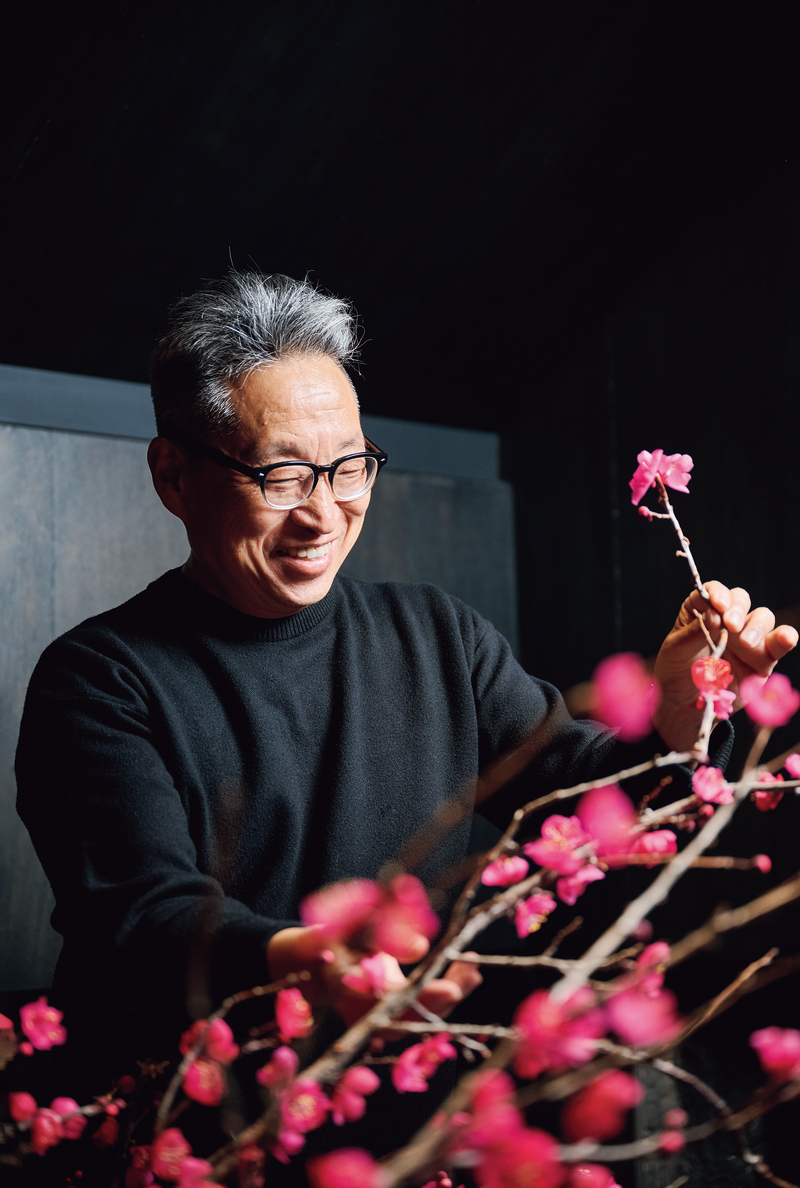
Each royal silk flower is produced through a long series of manual procedures, including dyeing, pounding, cutting, and ironing. Choi Sung-woo, a certified trainee in the traditional craft, believes it is the meticulous handiwork that makes the flowers so closely resemble their natural counterparts.
ⓒ Han Jung-hyun
Walking the streets of Tongui-dong, a neighborhood situated across the road from Yeongchu Gate, the west gate of Gyeongbok Palace, one may encounter an old two-story building nestled among more modern structures. A weathered, old-fashioned signboard bears the name “Boan Yeogwan” (Boan Inn). Founded in 1936, this inn was a home to many writers and artists over the years and welcomed guests until 2004, when it closed its doors due to financial difficulties. In the early 2000s, the neighborhood underwent rapid urban development, leading to the gradual demolition of many old buildings and the emergence of new ones in their place. The abandoned Boan Yeogwan would have shared a similar fate if not for Choi Sung-woo, who, in 2007, transformed the by then uninhabitable building into an arts and cultural space that now pulsates with vibrant energy.
Exuding vintage charm in the heart of modern Seoul, the building resonated with visitors and passersby to an extent that completely surpassed his expectations. It demonstrated the renewed significance of the past, and Choi, as the project’s CEO, gained recognition as a cultural planner instrumental to the revitalization of the Seochon area, also known as Seoul’s West Village.
RESTORATION OF ROYAL SILK FLOWERS
With a workshop on the fourth floor of the modern building to the left of Boan Yeogwan, Choi is also a certified trainee in the craft of royal silk flower making. His mother, Hwang Suro, is a master artisan who is credited with the revival of this traditional craft, which was almost lost after the Japanese occupation period. In recognition of her contribution, she was named the first heritage holder when the craft was designated National Intangible Cultural Heritage No. 124 in 2013.
Chaehwa were artificial flowers crafted from silk or ramie fabrics that were used during the Joseon Dynasty. Those used for court banquets and royal ceremonies, called gungjung chaehwa, were broadly categorized into three types: junhwa, vases of flowers decorating the throne; jamhwa, flowery headpieces worn by banquet attendees; and sanghwa, banquet table centerpieces. Records ing significant ceremonies and rites of the royal family, known as Royal Protocols of the Joseon Dynasty (Uigwe), feature illustrations depicting banquet scenes embellished with different kinds of royal silk flowers. Hongbyeok dohwajun, large vases with red and white silk flowers modeled after peach blossoms, sit flanking the throne. Jidangpan, a wooden platform recreating a lotus pond, is adorned with an array of silk lotus flowers. Notably, the head of every banquet attendee is adorned with red peach flowers bestowed by the king.
Historical literature provides detailed information on the types, sizes, production processes, quantities, and costs of the flowers. In 1795, King Jeongjo (r. 1776–1800) held a magnificent eight-day banquet to celebrate the 60th birthday of his mother, Lady Hyegyeong. A comprehensive account of the event, entitled Records of King Jeongjo’s Procession to the Tomb of Crown Prince Sado in Eulmyo Year (Wonhaeng eulmyo jeongni uigwe), notes that 11,919 bouquets of royal silk flowers were used for the banquet. While none of these fabric flowers have survived, Hwang managed to re them using the historical s as a guide.
The process of creating royal silk flowers involves dyeing, assembly, and installation. First, silk cloths selected for flower-making are dyed using natural pigments such as safflower and gardenia seeds. The cloths are then starched and beaten with a wooden roller to enhance their gloss and elasticity. Then, they are cut into petal shapes, which are smoothed and shaped with beeswax on a heated spatula iron. After this, the petals are arranged in the shape of a blooming flower, and stamens and pistils coated with pine pollen are inserted. The final step involves arranging the completed flowers, together with leaves and buds, on stems and branches. Since the entire process is done by hand, even flowers of the same type may vary in color and form. The individuality and variation of the flowers is what sets them apart from factory-made versions.
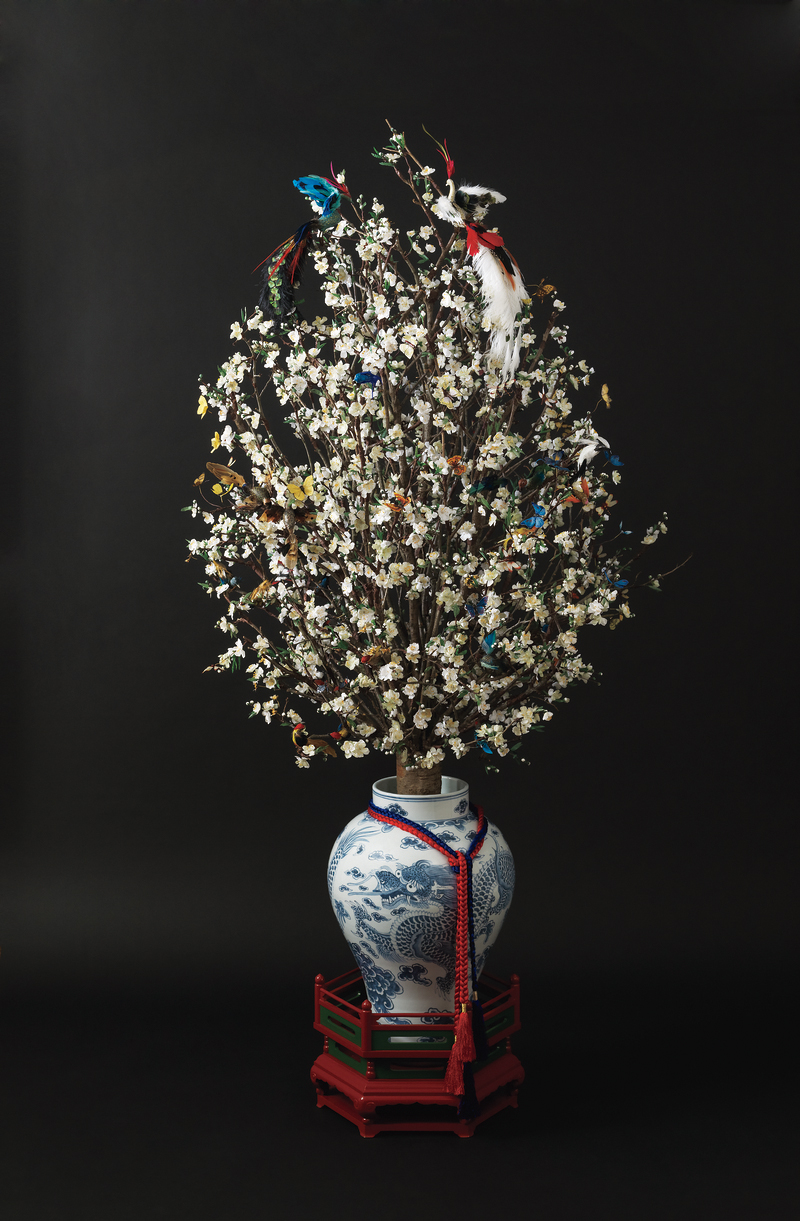
Hongbyeok dohwajun, large vases with red and white silk flowers modeled after peach blossoms, were placed on either side of the throne to decorate the audience hall. This three-meter-tall vase, filled with white silk flowers, exudes a sense of magnificence and dignity.
Courtesy of the Korean Royal Silk Flower Museum
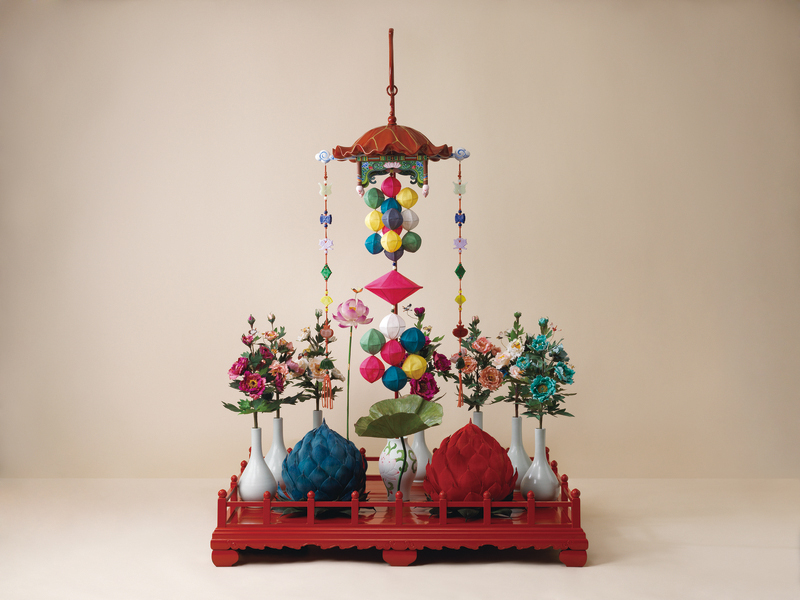
Master artisan Hwang Suro crafted this jidangpan, a recreation of a lotus pond, placing two lotus blossoms side by side, surrounded by seven vases of peony flowers, on a wooden platform. This model is based on platforms used to decorate the stage for court dances at the banquet held at Changgyeong Palace in 1829.
Courtesy of the Korean Royal Silk Flower Museum
BECOMING HIS MOTHER’S PUPIL
Choi was born in 1960 as the eldest of Hwang Suro’s three sons. He spent his childhood and school years living in his maternal grandparents’ home, a house in Busan’s Choryang-dong built during the Japanese occupation period. His maternal grandfather, Hwang Rae-sung, founded Taechang Corporation, a textile company that was the first in Korea to produce corduroy, while his own father, Choi Wee-kyung, was a Tokyo University-educated agricultural scientist who later succeeded his father-in-law as the company’s chairman.
“Since my mother was the only child, I practically grew up under my maternal grandparents’ care,” Choi says, describing his upbringing. “My maternal grandfather was kind to me, even though he was usually so stern that even my mother, who was known for her strictness, was afraid of him. I believe it was my grandfather’s influence that led me to develop an interest in cultural management after I majored in Western painting at university.”
In the early 1980s, amidst the political turmoil in the wake of the Gwangju Uprising, Choi spent most of his college years engaged in social activism through theater and traditional performances, after which he went to France to continue his studies. Having completed a doctoral program in art history at Université Paris 1 Panthéon-Sorbonne, he spent two years working as a research fellow at the French Ministry of Culture.
Choi explains, “I participated in a program where one researcher each from 13 different countries was selected to experience the quintessence of European culture. We were given access to various museum collections and systems, a rare opportunity not usually offered to the general public. This experience opened my eyes to the cultural management that integrates traditional values into contemporary life.”
After seven and a half years of studying in France, Choi returned to Korea in 1993. Circumstances dictated that he takes over the family business, a role in which he then spent almost a decade feeling out of place. He finally found his calling when he took over Boan Yeogwan. It was also around this time that the art of royal silk flower making caught his attention.
“In 2007, when the exhibition Traditional Korean Crafts was held at the United Nations headquarters in New York, I assisted my mother in exhibiting vases of royal silk flowers for the first time. I saw visitors flocking to take pictures of our exhibits and realized that flowers are a universal language that needs no explanation,” Choi says. Royal silk flowers received a similarly enthusiastic acclaim at a 2013 exhibition in Milan entitled Constancy and Change in Korean Traditional Craft.
Having watched his mother work, Choi was familiar with the handicraft from an early age, but inheriting her legacy was an entirely different proposition. “Those who learned the craft from my mother eventually left, even after they became certified trainees, because demand is inconsistent,” Choi explains. “I had no choice but to continue her legacy, but I couldn’t shake off the question ‘Why should I do this?’ Then, in 2014, while preparing for the exhibition Beautiful Royal Silk Flowers, I was truly awakened to the beauty of royal silk flowers.”
Held at the National Palace Museum of Korea, the exhibition was acclaimed for its recreation of the 1829 banquet held at Changgyeong Palace in celebration of the 40th birthday of King Sunjo and the 30th anniversary of his enthronement. Afterwards, Choi dedicated himself to formal training under his mother until he was officially recognized as a certified trainee in 2019. In the same year, the Korean Royal Silk Flower Museum opened its doors. The museum was constructed in Yangsan in South Gyeongsang Province, at her own expense.
In 2020, Choi opened the Royal Silk Flower Seoul Lab to develop and educate others on the traditional craft. He currently runs the lab while also serving as the director of the Yangsan museum, having succeeded his mother. “While the museum seeks to preserve traditional values that should not change, the lab is dedicated to promoting and experimenting with broader modern applications of the tradition,” Choi explains.
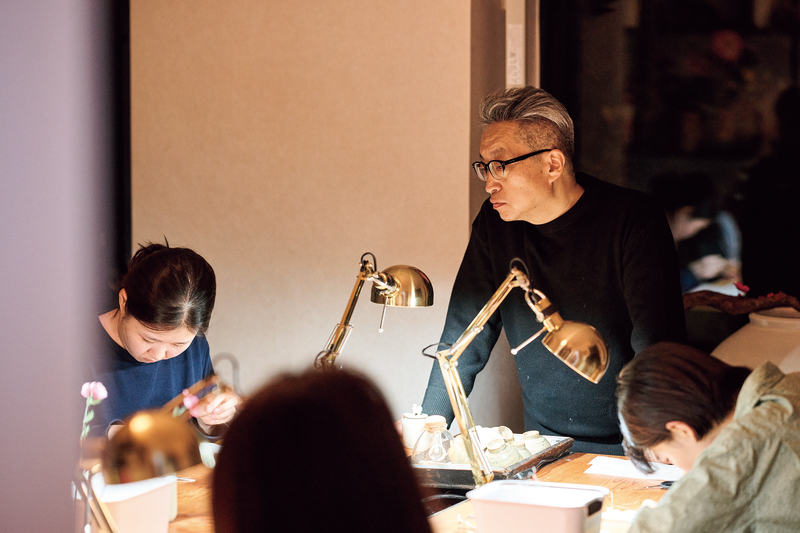
Choi teaches at the Royal Silk Flower Seoul Lab, which he established in the belief that the traditional craft should be integrated into contemporary life.
ⓒ Han Jung-hyun
MODERN INSTALLATIONS
Held at the Seoul Museum of Craft Art from September to November 2023, Choi’s exhibition Dialogue presented modern interpretations of royal silk flowers along with traditional recreations of red and white silk flowers in vases.
Describing his work, Choi says, “I believe the sculptural beauty of royal silk flower installations is, in itself, one of the greatest analog representations of the world of nature. For traditional royal silk flowers to appeal to contemporary tastes, it is essential to use modern techniques, means, and methods.” As both a certified trainee and cultural planner, Choi is now focused on addressing the question of how to use this traditional handicraft in the present day.
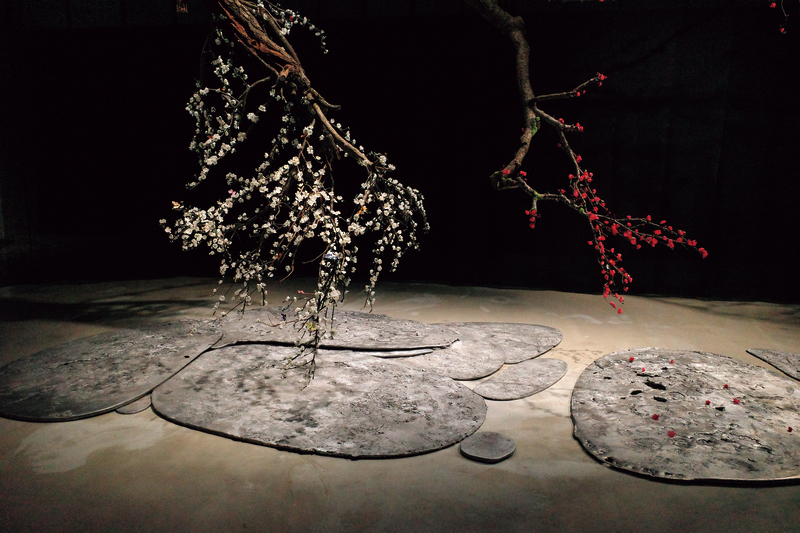
A scene from the exhibition Dialogue, held at the Seoul Museum of Craft Art in 2023. Choi collaborated with artists from the Royal Silk Flower Seoul Lab tothis contemporary interpretation of the traditional craft.
Courtesy of the Korean Royal Silk Flower Museum